Springerle
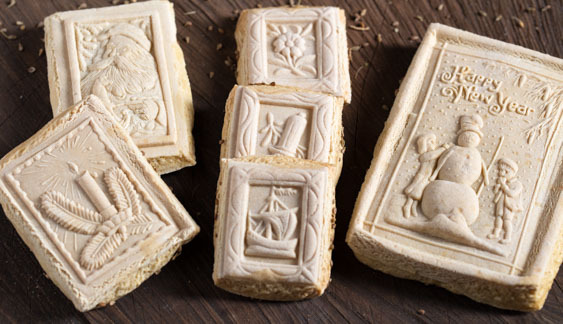
introduction
Americans in the upper Midwest probably bake more Springerle today than do most Germans. Yet these pale picture cookies in tablet form with their beautifully modeled surfaces, fine dryish crumb, and the spray of anise seeds stuck fast to the bottoms of their feet go back to the Middle Ages. In fact, archeological findings reveal that ancient Greeks and Romans embossed flatbread dough with molds made from stone and clay. The earliest Springerle in Germany and Switzerland were formed from molds depicting the pagan motifs—sunbursts, horses, cattle, and trees—and were offered to the gods at the celebration of the Winter Solstice. With the birth of Christianity, Springerle entered monasteries, where they joined Lebkuchen (already in progress). Indeed, the first monastic Springerle were made using Lebkuchen molds. Later, molds carved in the monasteries depicted Christian motifs such as angels, St. Nicholas, oxen and donkeys, Mary and Joseph, and the baby Jesus.
A particularly intriguing factoid about Springerle is that they evolved as a substitute for marzipan. The labor-intensive and extravagant delicacy from the Arab world—wrought of ground almond, sugar, and rose water and kneaded into a fine dough—marzipan was so expensive to produce or procure that Springerle filled in for it during the Advent season, and tolerated various inelegant nicknames such as “egg marzipan” and “farm marzipan.”
By the late 1700s, the center for all things Springerle was Stuttgart. The molds were carved from fruitwood and the beautifully wrought cookies they created were present for any and all festive occasions. Today, Springerle have all but disappeared from home kitchens in Germany. They are time consuming and require patience and attention. But difficult they are not.
Springerle are made from a whole-egg meringue scented with lemon zest and vanilla into which a ton flour is kneaded, making the dough something of a sweet modeling clay and production more like a craft project than a culinary adventure. Once rolled out, the cookie dough is pressed into Springerle molds with their intaglio carvings, released with relief designs intact, and made to dry overnight at room temperature. The moist bottoms of the cookies are swept across a field of anise seeds on the cookie sheet and the baking sheet is set in the oven where the cookies’ dry top surfaces and soft underbellies promote the crucial pedestal formation of little feet. To keep up appearances and ensure the cookies’ resemblance to marzipan, Springerle are baked at low temperatures and shielded from coloring with a baking sheet on an upper oven rack.
We love Springerle. They’re not far from biscotti in tone and temperament, but their texture is fine, not porous—almost like a layer of cake that suddenly became a cookie—and they crumble pleasingly in the mouth. We adore the Springerle’s thickness and its appealing colloquy between vanilla, lemon, and anise. Germans often complain that Springerle are too hard. American recipes seem to address this issue by adding butter to the recipe. Butter is nice in Springerle, but not essential. If the cookies are left out at room temperature for a few days—particularly if the climate is damp and chilly (like Germany in December)—before hustling them off to a cookie tin, they will soften over the ensuing week or two. We should also note that whereas most Springerle cookies are strikingly sweet, ours strike just the right level of sweetness.
Baking Notes
Comporting with their age and tradition, many German Christmas cookies use an ancient form of leavening called Hirschhornsalz. In the United States, it is known as baker’s ammonia (short for ammonium carbonate). The substance smells ghastly, but it does good things in baked goods (its odor dissipates at temperatures above 140 degrees). Because baker’s ammonia is not activated by liquid, but by heat, doughs made with it may be left to ripen in the refrigerator without suffering any loss of oven bounce. Cookies bake up crisp, with an open crumb, and stay crisp for long periods. King Arthur Flour sells baker’s ammonia.
Please pay close attention to the weights and sequences in this recipe. The place you can run into real trouble is in the dough’s final texture: it must not be too sticky or too crumbly. After it has rested overnight, the dough should be firm enough that it may be pressed heavily into the molds. The correct thickness of the rolled-out dough is also critical. Don’t go crazy flouring the molds and be sure to brush the flour off the molded cookies before they sit out to dry overnight.
Springerle cookies won’t get done without Springerle molds. If you have the rolling-pin style of mold, we apologize, but we did not perform tests with this type and cannot recommend it. Whether round or rectangular, deeply detailed individual Springerle molds—ours were 2 to 6 inches high—work best. The trick is working with a single mold and piece of dough at a time. We purchased some really beautiful specimens from Ken Hamilton at The Springerle Baker. Ken carves resin replicas from a collection of antique molds. They are easier to work with than wooden molds and his designs are lovely and detailed. Another source for Springerle molds is House on the Hill.
equipment mise en place
For this recipe, you will need a digital kitchen scale, a fine-mesh strainer, a ramekin, a stand mixer with whisk and flat-beater attachment, a saucepan onto which the mixer bowl sits securely, a whisk, a digital instant-read thermometer, a gallon-sized zipper-lock bag, a rolling pin, four baking sheets, two silicone mats or parchment paper, a pair of scissors, a metal bench knife, various Springerle molds, and a pastry brush.
-
-
20ounces Anson Mills Artisan Fine Cloth-Bolted White Lammas Cake Flour, plus additional for sprinkling the dough
-
1½teaspoons hot water
-
½teaspoon fine sea salt
-
1tablespoon Kirschwasser
-
½teaspoon baker’s ammonia
-
4large eggs (7 ounces, without shells)
-
7ounces confectioners’ sugar, sifted
-
7ounces superfine sugar
-
2plump, fragrant vanilla beans (preferably Bourbon), split lengthwise
-
2tablespoons finely grated lemon zest
-
1½tablespoons whole anise seeds
-
-
Sift the flour and salt together through a fine-mesh strainer. In a ramekin, stir together the hot water and baker’s ammonia until the baker’s ammonia dissolves; set the mixture aside.
-
Turn the eggs, confectioners’ sugar, and superfine sugar into a clean stand mixer bowl and set the bowl snugly onto a saucepan filled with about 2 inches of water (the water should not touch the bottom of the bowl). Set the saucepan over medium heat and whisk until the mixture registers 130 degrees on a digital instant-read thermometer, about 5 minutes. Attach the bowl to the stand mixer fitted with the whisk attachment. Using a paring knife, scrape the seeds from the vanilla bean halves and drop the seeds into the egg mixture along with the lemon zest. Beat on high speed until the mixture is pale yellow and thick (fig. 2.1), about 10 minutes. Reduce the speed to low, add the Kirschwasser, and mix to incorporate. Remove the whisk, knock it clean against the side of the bowl, and attach the flat-beater to the mixer. With the mixer running on low speed, add the flour in 3 batches. Add the dissolved baker’s ammonia and mix on low speed for 10 minutes; the dough will become strong, sinewy, and very sticky, and the machine will buck like a pony. Turn the dough out onto the countertop and knead it for a couple of minutes without adding additional flour; it will be heavy and sticky but fine and very smooth (fig. 2.2). Place the dough in a gallon-sized zipper-lock bag, and, using a rolling pin, roll the dough so that if fills the entire bag (fig. 2.3); it will be the desired thickness. Seal the bag and refrigerate overnight, laid flat.
-
Line a baking sheet with a silicone mat or parchment paper. Using a pair of scissors, cut the bag away from the dough and divide the dough into three equal strips with a metal bench knife. Pull one strip aside and cover the other two with plastic wrap. Using the bench scraper, cut a piece of the dough to correspond with the shape but is slightly larger than the mold you intend to work with. Very lightly flour the surface of the piece of dough and invert it over the mold. Press the dough into the depressions with your fingers (fig. 3.1), and then pass a rolling pin over the dough, applying firm pressure (fig. 3.2). Invert the mold with the dough, and then lift the form away from the imprinted cookie (fig. 3.3). Cut around the edges of the design with the bench knife. Lay the cookie on the prepared baking sheet. Using a pastry brush, dust off excess flour from the surface (fig. 3.4) and brush the mold clean of any bits of dough or flour before forming additional cookies. Repeat this process with the remaining dough, working the scraps back in. Let the cookies dry, uncovered, at room temperature overnight.
-
Adjust the oven racks to the upper-middle and lower-middle positions. Place a baking sheet on the upper rack (it will prevent the cookies from browning) and heat the oven to 300 degrees. Line another baking sheet with a silicone mat or parchment paper and place another baking sheet under it for insulation. Sprinkle the prepared baking sheet with the anise seeds. Brush the bottom of each cookie with water (fig. 4.1) and set it on the anise-sprinkled baking sheet so that some seeds adhere. (The moist underside of the cookie will rise and produce “little feet” in the oven.) Arrange the cookies in close-fitting rows. Bake on the lower rack until the springerle have risen and are lightly golden on the bottom but remain pale on top, about 20 minutes (fig. 4.2). With luck, they will have little feet (fig. 4.3)! Turn off the oven and let the cookies cool in the oven. Allow the Springerle to mellow for a few days in an airtight container so that they soften slightly; they will keep for up to 3 months.
-
-
2.1

-
2.2

-
2.3

-
-
-
3.1

-
3.2

-
3.3
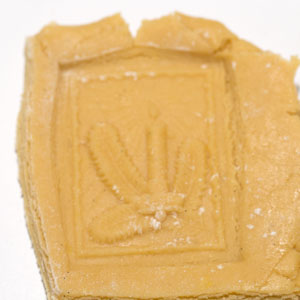
-
3.4
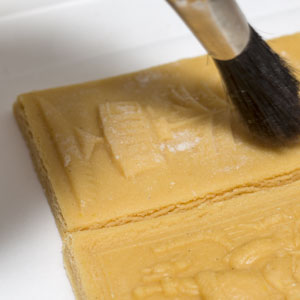
-
-
-
4.1

-
4.2
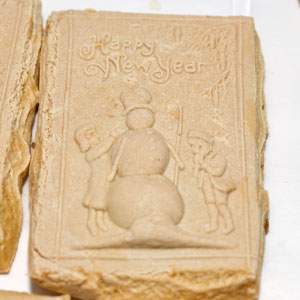
-
4.3
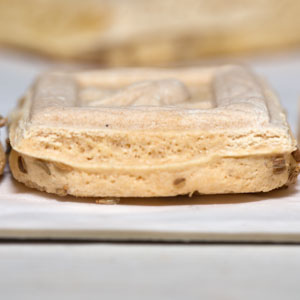
-